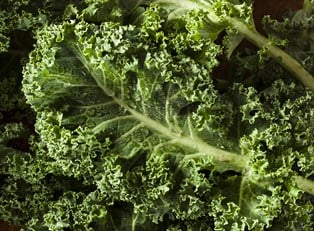Until around 2007, Americans mostly used this hardy, earthy-tasting green as a garnish, with many people associating it with the frilly greens as salad bar decor. But from 2007 to 2012, kale production increased by roughly 60 percent as kale blew up on the culinary scene with renewed vigor. Television personality, Dr. Mehmet Oz, featured kale on one of his shows in 2010. A year later, the Ellen talk show featured a segment with Gwyneth Paltrow baking kale chips and, in 2012, Bon Appétit officially declared it “the year of kale.”
Ever since, you can hardly go to any restaurant without seeing some iteration of kale on the menu. From kale Caesar salads to stir-fries to pizzas and more, kale has been nearly everywhere in one form or another as people’s appetites for this flavorful, cruciferous vegetable became insatiable.
This is for good reason—there are a variety of health benefits associated with eating kale. It’s rich in vitamins C, E, and K as well as selenium, beta-carotene, calcium, potassium, lutein, and zeaxanthin, among other nutrients. Eating kale may help support immunity, enhance heart health, support healthy bones, and lower your risk of age-related eye issues like cataracts.
It makes you want to load up on kale, right? Not so fast. Although it’s low in calories and nutrient-dense, it is possible to have too much of a good thing. In some cases, it can be detrimental to your health. It helps to understand the symptoms of eating too much kale so you know exactly what to watch for.
Symptoms of a Kale Overdose
Too much of anything isn’t good. Kale is no different. Despite its many benefits, eating large quantities can give you some unpleasant side effects, the likelihood of which increases depending on how much kale you eat. Five main symptoms include:
- Gastrointestinal distress: Kale is a fiber-rich cruciferous vegetable. Eating large volumes can cause gas, diarrhea, bloating, and constipation.
- Dehydration: Kale has natural diuretic properties, which may increase your urinary frequency. Large quantities can cause dry mouth or, even worse, dehydration. Your major organs all need adequate hydration to function. Severe dehydration can also cause rapid heartbeat, drowsiness, and dry skin.
- Thyroid dysfunction: Kale contains a substance called progoitrin, which can be problematic if you eat large amounts of kale or you have an underactive thyroid. This compound can interfere with how your thyroid functions, potentially blocking your body's ability to synthesize thyroid hormone production and leading to weight gain and blood sugar fluctuations.
- Hypoglycemia: This low-glycemic food can help regulate your blood sugar by slowing your body’s absorption of sugar and slowly releasing its sugars into your bloodstream to prevent rapid spikes. In large quantities, kale can cause a drop in blood sugar levels, increasing your chances of hypoglycemia, which is marked by symptoms like shakiness, irritability, sweating, and weakness.
- Hypotension: The nutrients in kale can help regulate your blood pressure. It boosts healthy blood circulation and relaxes blood vessels, which can increase heart health. But when you eat too much kale, it can cause your blood pressure to drop too low, causing symptoms like dizziness, blurred vision, fatigue, and lightheadedness.
Who Should Minimize Kale Consumption?
If you have an allergy to cruciferous vegetables, you should avoid or minimize how much kale you eat. Additionally, eating kale in large quantities can cause a kale allergy, which results in symptoms like hives, rash, dizziness, or swelling of the mouth or throat. Likewise, if you have certain medical conditions, you should limit the amount of kale you eat.
For example, if you have kidney disease, the potassium in kale could be harmful in large doses. If you take blood thinners, the vitamin K found in kale can
Interact with your medication. Likewise, if you take beta blockers, which can increase potassium in your body, you should talk to your doctor about how much kale is safe to eat.
How Much Kale Should You Eat?
The United States Department of Agriculture's Dietary Guidelines recommends that most people eat approximately 2.5 cups of vegetables daily. This is the equivalent of five cups of raw leafy greens or 2.5 cups of cooked greens. Many experts recommend limiting yourself to no more than one or two servings of kale daily and pairing it with foods like nuts, avocado, or olive oil to help your body better absorb fat-soluble vitamins. Pairing it with vitamin C-rich foods like lemon juice or strawberries can help your body better absorb iron from this dark, leafy green.
Ultimately, the healthiest diet is rich in variety. Enjoy kale in moderation unless your doctor recommends otherwise. Be sure to include a rainbow of other fruits and vegetables to ensure optimal nutrition while minimizing the potentially harmful side effects of eating too much of any one food.



